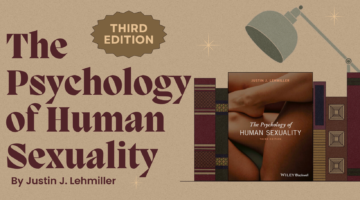Fact Check: Do Pheromones Really Exist in Humans?
June 11, 2012 by Justin Lehmiller
Everyone knows that pheromones exist in animals. For example, if you’ve ever been around a female dog while she’s in heat, you have probably seen and heard all of the male dogs that live on the block going crazy. But do pheromones also exist in humans? Over the past few decades, scientists have come to the conclusion that humans do indeed secrete pheromones through sweat glands around the armpits and genitals, and these scents appear to have implications for our sexual behavior. In this article, we’ll explore just a few of the ways that our sense of smell may be affecting our sex lives.
Scientists started to believe that pheromones might exist in the early 1970s when Martha McClintock discovered that female college students living near one another developed menstrual synchrony (i.e., they started to have their periods around the same time) [1]. Was it because the women were picking up on each other scents? A subsequent study suggested that they probably were [2]. Female participants had another woman’s sweat placed on their upper lip a few times each week for several months. Women who were exposed to the sweat were more likely to show menstrual synchrony than women who did not receive the sweat application. This is actually a pretty cool study if you can overlook the fact that participants had someone else’s armpit sweat rubbed on their faces repeatedly.
Although more recent research has called the menstrual synchrony phenomenon into question, a variety of other studies have popped up suggesting that pheromones do indeed affect our sexuality. For instance, some research suggests that pheromones may help put us “in the mood” more often. In two double-blind, placebo-controlled experiments, men and women were randomly assigned to apply either a synthetic pheromone or a placebo solution to their skin each day for a few weeks [3,4]. All of the participants completed a survey asking about their sexual activities during that time. The researchers found that participants wearing pheromones reported more frequent sex than participants wearing the placebo, and this was true for both men and women! Although we can’t say exactly why this effect occurred (i.e., did wearing pheromones make people feel sexier or did the scent actually help participants to attract more partners?), it does seem clear that there’s something going on here.
One other fascinating research finding is that these sexual effects are not limited to heterosexuals. For instance, in a recent study, participants had to sniff armpit sweat supplied by men and women of different sexual orientations [5]. Participants were not informed where any of the odors came from and were simply asked to indicate which ones they liked more or less. The least preferred odor for straight men and women came from gay men, and the least preferred odor for gay men came from heterosexual men. This suggests that, among people of all sexual orientations, one of our nose’s jobs may be to lead us to sexual partners with whom we are most compatible.
In short, although the effects of pheromones in humans do not appear to be quite as dramatic as they are in some of our animal friends, your nose may know more than you think!
Want to learn more about Sex and Psychology? Click here for previous articles or follow the blog on Facebook (facebook.com/psychologyofsex), Twitter (@JustinLehmiller), or Reddit (reddit.com/r/psychologyofsex) to receive updates.
[1] McClintock, M. K. (1971). Menstrual synchrony and suppression. Nature, 229, 244–245.
[2] Preti, G., Cutler, W. B., Garcia, C. R., Krieger, A., Huggins, G. R., Lawley, H. J. (1986). Human axillary secretions influence women’s menstrual cycles: The role of donor extracts of females. Hormones and Behavior, 20, 474–482.
[3] Cutler, W. B., Friedmann, E., & McCoy, N. L. (1998). Pheromonal influences on sociosexual behaviour in men. Archives of Sexual Behavior, 27, 1–13.
[4] McCoy, N. L, & Pitino, L. (2002). Pheromonal influences on sociosexual behaviour in young women. Physiological Behavior, 75, 367–375.
[5] Martins, Y., Preti, G., Crabtree, C. R., Runyan, T., Vainius, A. A., & Wysocki, C. J. (2005). Preference for human body odors is influenced by gender and sexual orientation. Psychological Science, 16, 694-701.
Image Source: iStockphoto.com
You Might Also Like:

Dr. Justin Lehmiller
Founder & Owner of Sex and PsychologyDr. Justin Lehmiller is a social psychologist and Research Fellow at The Kinsey Institute. He runs the Sex and Psychology blog and podcast and is author of the popular book Tell Me What You Want. Dr. Lehmiller is an award-winning educator, and a prolific researcher who has published more than 50 academic works.
Read full bio >


